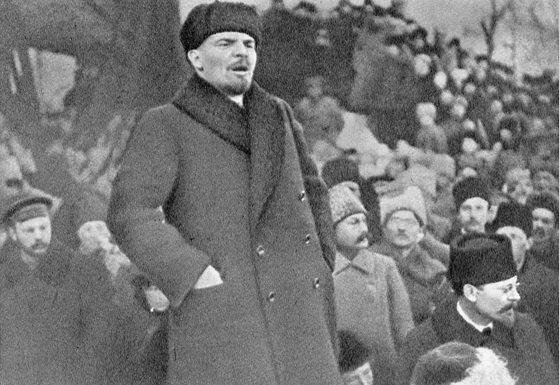In Russian the “Aprelskiye Tezisy”, the April Theses formed a programme developed by Lenin during the 1917 Russian Revolution. In these Lenin called for Soviet control of the state. When published the theses contributed to the July Days rising and to the subsequent coup d’etat of October 1917, bringing the Bolsheviks to power.
- Condemns the Provisional Government as bourgeois and urges “no support” for it, as “the utter falsity of all its promises should be made clear.” He condemns World War I as a “predatory imperialist war” and the “revolutionary defensism” of foreign social democrat parties, calling for revolutionary defeatism.
- Asserts that Russia is “passing from the first stage of the revolution—which, owing to the insufficient class consciousness and organization of the proletariat, placed power in the hands of the bourgeoisie—to its second stage, which must place power in the hands of the proletariat and the poorest sections of the peasants.”
- Recognises that the Bolsheviks are a minority in most of the soviets against a ‘block of all the petty-bourgeois opportunist elements, from the Social-Cadets and the Socialist Revolutionaries down to the Organising Committee (Chkheidze, Tsereteli, etc.), Steklov, etc., etc., who have yielded to the influence of the bourgeoisie and spread that influence among the proletariat.’
- Calls for a parliamentary republic not to be established and calls this a “retrograde step.” He calls for “a republic of Soviets of Workers’, Agricultural Labourers’ and Peasants’ Deputies throughout the country, from top to bottom.”
- Calls for “abolition of the police, the army, and the bureaucracy” and for “the salaries of all officials, all of whom are elective and displaceable at any time, not to exceed the average wage of a competent worker.”
- Calls for “The weight of emphasis in the agrarian programme to be shifted to the Soviets of Agricultural Labourers’ Deputies,” confiscation of all landed estates,” and “nationalisation of all lands in the country, the land to be disposed of by the local Soviets of Agricultural Labourers’ and Peasants’ Deputies. The organisation of separate Soviets of Deputies of Poor Peasants. The setting up of a model farm on each of the large estates (ranging in size from 100 to 300 dessiatines, according to local and other conditions, and to the decisions of the local bodies) under the control of the Soviets of Agricultural Labourers’ Deputies and for the public account.”
- Calls for “the immediate union of all banks in the country into a single national bank, and the institution of control over it by the Soviet of Workers’ Deputies.”
- States that “it is not our immediate task to ‘introduce’ socialism, but only to bring social production and the distribution of products at once under the control of the Soviets of Workers’ Deputies.”
- Lists “party tasks” as “Immediate convocation of a party congress,” “alteration of the party programme, mainly: (1) On the question of imperialism and the imperialist war, (2) On our attitude towards the state and our demand for a “commune state,” amendment of our out-of-date minimum programme,” and change of the Party’s name.” Lenin notes that “instead of “Social Democracy,” whose official leaders throughout the world have betrayed socialism and deserted to the bourgeoisie (the ‘defencists’ and the vacillating ‘Kautskyites’), we must call ourselves the Communist Party.” The name change would dissociate the Bolsheviks from the social democratic parties of Europe supporting participation of their nation in World War I. Lenin first developed this point in his 1915 pamphlet”Socialism and War,” when he first called the pro-war social-democrats “social chauvinists.”
- Calls for a new “revolutionary International, an International against the social-chauvinists and against the ‘Center.'” This later became the Comintern (Third International) which was formed in 1919.

